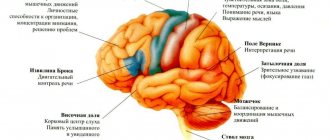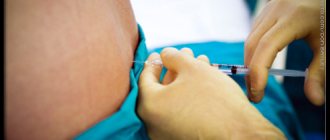Why is meningitis dangerous?
Meningitis is expressed in the rapid inflammation of the membrane of the brain, under which serous fluid accumulates. If misdiagnosed, untimely access to doctors and improper treatment, the disease can lead to cerebral edema and result in disability or even death.
Unlike purulent meningitis, serous meningitis is not accompanied by massive death of nerve cells. Therefore, the chances of recovery and a favorable outcome with the serous type of the disease are higher.
Serous and purulent types of meningitis at the cellular level are diseases of opposite nature. It is very difficult to distinguish them externally. In fact, there is only one reliable diagnostic method - lumbar puncture of the cerebrospinal fluid and its subsequent analysis.
Meningitis
Encephalitis
Fungus
Vomit
Rubella
Measles
29897 07 June
IMPORTANT!
The information in this section cannot be used for self-diagnosis and self-treatment.
In case of pain or other exacerbation of the disease, diagnostic tests should be prescribed only by the attending physician. To make a diagnosis and properly prescribe treatment, you should contact your doctor. Meningitis: causes, symptoms, diagnosis and treatment methods.
Definition
Meningitis is an infectious inflammation of the meninges of the brain and spinal cord, accompanied by intoxication, fever, increased intracranial pressure syndrome, meningeal syndrome, as well as inflammatory changes in the cerebrospinal fluid.
The meninges are connective tissue membranes that cover the brain and spinal cord. There are dura mater, arachnoid and pia mater.
The dura mater of the brain has a dense consistency and thickness of 0.2-1 mm; in places it fuses with the bones of the skull. The arachnoid membrane is a thin, translucent, non-vascular connective tissue plate that surrounds the brain and spinal cord. The soft shell is a thin connective tissue plate directly adjacent to the brain, corresponds to its relief and penetrates into all its recesses. In its thickness is the vascular network of the brain.
The most common inflammation is inflammation of the pia mater, and the term “meningitis” is used.
Causes of meningitis
The meninges can be involved in the inflammatory process primarily and secondary. Meningitis that occurs without a previous general infection or disease of some other organ is called primary. Secondary meningitis develops as a complication of an existing infectious process. Secondary ones include tuberculous, staphylococcal, pneumococcal meningitis. The primary ones are meningococcal, primary mumps, enteroviral meningitis and others.
The disease is transmitted by airborne droplets, household contact or nutrition.
Purulent inflammation of the meninges can be caused by various bacterial flora (meningococci, pneumococci, and less commonly, other pathogens). The cause of serous meningitis is viruses, bacteria, fungi.
According to the forecast, the most dangerous is tuberculous meningitis, which occurs when there is a tuberculous lesion in the body. The development of the disease occurs in two stages. At the first stage, the pathogen, through the bloodstream, infects the choroid plexuses of the ventricles of the brain with the formation of a specific granuloma in them. In the second, inflammation of the arachnoid and soft membranes is observed (as a rule, the membranes of the base of the brain are affected), which causes acute meningeal syndrome.
The development process of meningococcal meningitis also consists of several stages:
- contact of the pathogen with the mucous membrane of the nasopharynx;
- entry of meningococcus into the blood;
- penetration of the pathogen through the blood-cerebrospinal fluid barrier, irritation of pia mater receptors by toxic factors and inflammation.
The course of the infectious process depends on the pathogenic properties of the pathogen (the ability to cause disease) and the state of the human immune system.
Previous viral diseases, sudden climate change, hypothermia, stress, concomitant diseases, therapy that suppresses the immune system can be significant for the occurrence and course of meningitis.
Classification of the disease
According to the type of pathogen:
- Viral meningitis (influenza, parainfluenza, adenovirus, herpes, arbovirus (tick-borne), mumps, enterovirus ECHO and Coxsackie).
- Bacterial meningitis (meningococcal, tuberculous, pneumococcal, staphylococcal, streptococcal, syphilitic, brucellosis, leptospirosis).
- Fungal (cryptococcal, candidiasis, etc.).
- Protozoal (toxoplasmosis, malaria).
- Mixed.
According to the nature of inflammation:
- Serous.
- Purulent.
According to the mechanism of occurrence:
- Primary.
- Secondary.
With the flow:
- Spicy.
- Subacute.
- Fulminant.
- Chronic.
By severity:
- Easy.
- Medium-heavy.
- Heavy.
According to the prevalence of the process:
- Generalized.
- Limited.
According to the presence of complications:
- Complicated.
- Uncomplicated.
Symptoms and syndromes of meningitis
There are a number of syndromes common to all meningitis:
- meningeal syndrome - manifested by rigidity (increased tone) of the neck muscles and long back muscles, hypersthesia (increased sensitivity) of the sensory organs, headache, vomiting, changes in the cerebrospinal fluid;
- cerebral syndrome - manifested by drowsiness, impaired consciousness, nausea, vomiting, dizziness, psychomotor agitation, hallucinations;
- asthenovegetative syndrome – manifested by weakness, decreased ability to work;
- convulsive syndrome;
- general infectious syndrome - manifested by chills and fever.
Meningococcal meningitis ranks first among purulent meningitis.
Its incubation period ranges from 1 to 10 days, with an average of 2-4 days. The disease usually begins acutely against the background of complete health or shortly after nasopharyngitis. Patients can indicate not only the day, but also the hour of illness; they are worried about chills, body temperature above 38℃, severe bursting headache, aggravated by any noise and movement of the head. Patients may experience pain in various parts of the body, and touching causes excruciating sensations. Vomiting is not associated with food intake and does not bring relief. Soon, stiffness of the neck and long back muscles sets in. Patients take a “meningeal” position. Infants cry constantly, they may experience bulging fontanelles and gastrointestinal disorders. Pneumococcal meningitis, as a rule, is observed in young children against the background of an existing pneumococcal process (pneumonia, sinusitis).
With streptococcal meningitis, hepatolienal syndrome (enlarged liver and spleen), renal failure, adrenal insufficiency, petechial rash (hemorrhages due to damage to the capillaries, as a result of which blood, spreading under the skin, forms round spots, the size of which does not exceed 2 mm).
Purulent meningitis caused by Pseudomonas aeruginosa and fungi are rare. The diagnosis is established only after additional laboratory tests.
Serous tuberculous meningitis is characterized by a gradual onset, although in rare cases it can manifest itself acutely. At the onset of the disease, patients complain of fatigue, weakness, irritability, and sleep disturbances. The temperature is usually no higher than 38℃, and there is an intermittent moderate headache. On the 5-6th day of illness, the temperature rises above 38℃, the headache intensifies, nausea, vomiting, and drowsiness appear. Unconsciousness develops quickly. A divergent strabismus, a low position of the upper eyelid in relation to the eyeball, and pupil dilation may be observed.
When diagnosing mumps meningitis, it is important to identify recent contact with someone with mumps.
Clinical manifestations of damage to the meninges may develop even before the enlargement of the salivary glands.
Enteroviral meningitis is characterized by two- and three-wave fever with intervals between waves of 1-2 or more days. Other manifestations of enterovirus infection are almost always observed (muscle pain, skin rash, herpangina).
For the diagnosis of measles and rubella meningitis, an indication of contact with a patient with these diseases, as well as typical clinical symptoms of measles or rubella, is of great importance.
Diagnosis of meningitis
To confirm the diagnosis of meningitis, the doctor may prescribe a set of laboratory and instrumental studies:
- clinical blood test with determination of hemoglobin concentration, number of erythrocytes, leukocytes and platelets, hematocrit and erythrocyte indices (MCV, RDW, MCH, MCHC), leukoformula and ESR (with microscopy of a blood smear in the presence of pathological changes);
Where does the disease come from?
By its origin, serous meningitis can be:
- Primary – brain damage directly from a viral or bacterial attack.
- Secondary - develops against the background of another disease that causes a weakened immune system.
The causative agents of the disease can be:
- viruses;
- bacteria;
- fungi.
According to medical statistics, among childhood morbidity, viral pathogens account for 80% of cases of serous meningitis. Children of preschool age - from three to six years old - are susceptible to inflammation of the meninges. Schoolchildren and adults to a lesser extent.
Acute serous meningitis is most often caused by enteroviruses. Among them, there are two main ones: the ECHO virus and the Coxsackie virus.
In more rare cases, the reasons are:
- Epstein-Bar virus (is the causative agent of infectious mononucleosis);
- cytomegalovirus;
- herpes;
- measles;
- influenza viruses (especially highly mutagenic ones).
In medicine, there are three ways of transmitting the disease:
- Contact – with a handshake and other touches by the wearer. In the latter, the virus is most often localized on the hands, skin lesions, mucous membranes of the mouth and eyes.
- Airborne - concentration of the virus in the respiratory tract. It is transmitted by inhaling air that contains saliva particles containing the pathogen in the form of an aerosol.
- Alimentary (fecal-oral) method - a susceptible organism ingests water contaminated with enteroviruses. In recent years, outbreaks of meningitis have become common in the summer, when the swimming season is in full swing. The infection, entering the child’s mouth with water, accumulates in the intestines. Later it is excreted in feces and again ends up in the water.
Enteroviruses retain their vital functions on food products for a long time. Personal hygiene, thorough washing of vegetables and fruits reduce the risk factor.
The incubation period of the disease varies from several hours (acute form) to several days. In this case, the first symptoms of serous meningitis in children may appear only a week after the direct infection.
Symptoms
The symptoms of serous meningitis are similar to those with purulent lesions. There is a fever, a severe headache quickly develops, accompanied by nausea and vomiting, which does not bring relief. All the shell symptoms appear quite quickly - the person begins to react aggressively to stimuli (light, sound), sometimes takes a pose with his head thrown back. Sometimes there is a picture of depression of consciousness, however, much less frequently than with bacterial damage.
Cranial nerves are rarely involved in the process, but neuropathy of the oculomotor, facial and other cranial nerves, manifested by characteristic symptoms (strabismus, facial asymmetry, etc.), can also occur.
In severe cases, especially with aggravated somatic status, complications may develop. The most dangerous would be an ischemic or hemorrhagic stroke occurring against the background of an underlying disease.
Symptoms
When the incubation period ends, serous meningitis manifests itself with sharp and obvious signs, which are collectively called meningeal syndrome.
A sick child exhibits several symptoms from this list:
- Fever. An indispensable symptom of serous meningitis, occurring in two waves. First, the temperature rises to 39.5-40 degrees and usually lasts for about three days. Then it subsides and returns again in a day or two. In mild cases, the temperature may return in a “truncated” version – 37-38 degrees.
- Severe headache. It starts from the temples and smoothly moves to the back of the head. Bright light and noise increase pain.
- A characteristic symptom of childhood serous meningitis is limb cramps.
- Lack of appetite, nausea, vomiting (without relief), diarrhea, abdominal pain.
- Intoxication, which entails joint pain, general weakness, moodiness and irritability of the child.
- In children, meningitis is often accompanied by standard symptoms of respiratory diseases - runny nose and sore throat. Therefore, parents sometimes mistake it for acute respiratory infections and do not sound the alarm.
- Sick children from three years of age try to take a characteristic position: lying on their side, pressing their hands to their chest and knees to their stomach. The head is thrown back towards the back.
- The acute form of meningitis may be accompanied by impaired motor functions (partial paralysis and paresis).
- Double vision and strabismus are another symptom of the so-called reactive meningitis, which develops over a few hours.
- An attentive parent may notice increased tension in the neck muscles.
- Disorders of consciousness: from stupor and absent-mindedness to coma (in advanced acute form).
These signs can manifest themselves to a greater or lesser extent, singly, in groups or complexly.
For an accurate diagnosis, we check for the presence of certain types of meningeal syndromes:
- Kernig syndrome, when a child cannot straighten a leg bent at an angle of 90 degrees.
- Brudzinski syndrome is a reflex flexion of one leg while bending the other (or flexion of the legs simultaneously with flexion of the head).
- Lesage syndrome (for infants): when you hold a baby by the armpits, he bends his legs and pulls them towards his stomach. Swelling of the fontanelle is also observed.
- Mondonesi syndrome is a severe headache with light pressure on the eyeballs covered by the eyelids.
Some of the symptoms of serous meningitis are similar to those of the meningeal form of tick-borne encephalitis. Because this parasite is active during the summer (as are meningitis outbreaks), the diseases can be confused.
Symptoms of serous meningitis
Serous meningitis in children usually begins with a sharp rise in temperature and the appearance of a severe headache, after which other signs of this disease may appear. The virus is extremely stable in the external environment and can easily exist, for example, in tap water, for up to several weeks, and can even withstand short boiling. Most often, this type of meningitis affects children of preschool and school age. The acute period of this disease lasts 3-5 days, and approximately 2 weeks pass before complete recovery occurs. In many children, the signs of meningitis are not clearly expressed, which causes an incorrect diagnosis. But despite this, the prognosis regarding the consequences of the disease and recovery with serous meningitis in children is more favorable.
There are a number of signs of meningitis in children, they are called meningeal syndrome. Cases when signs of meningitis appear all at once in children, especially in children, are not very common.
Main signs of meningitis in children
- Strong headache. (May be aggravated by exposure to light and sound)
- Vomit
- Lethargy. In almost all cases, the child simply lies flat
- Heat. (Practically not affected by conventional antipyretics)
- Muscle stiffness. Try with the child lying on his back to press his chin to his chest. If muscle rigidity is observed, this is very difficult to do, and more often than not, simply impossible.
- Sick children try to lie on their side with their legs tucked in and their head thrown back.
- In babies under one year of age, the fontanel may swell.
All of the listed signs of meningitis in children are indirect and serve only to make a preliminary diagnosis. The final diagnosis, and accordingly treatment, is determined only by the results of a spinal puncture. Unfortunately, this far from unpleasant procedure is the only accurate method for diagnosing this disease. When serous meningitis occurs in children, doctors usually give a favorable prognosis, except in special cases. The child is placed in a hospital for treatment, where he spends 2-3 weeks under the supervision of doctors. Subsequently, a child who has had serous meningitis is registered with a neurologist. The most important condition for correct, complete treatment with subsequent recovery is a correct and timely diagnosis.
When a spinal puncture is taken from a child with meningitis, the cerebrospinal fluid is milky-colored and flows out under pressure. But, despite the fact that the procedure is somewhat painful, after it the child immediately feels better, the headache practically goes away, and the temperature gradually returns to normal.
Meningitis is a dangerous disease with its consequences. If you do not seek medical help in time, the consequences of serous meningitis can be:
- Hearing loss (partial or complete)
- Loss of vision
- Speech apparatus disorders
- Children may experience mental retardation.
In particularly severe cases, coma or death
How to fight the disease
Parents who suspect that their child has inflammation should first call an ambulance. Diagnosis and treatment of serous meningitis in children should be carried out by specialists.
For mild meningitis, doctors usually limit themselves to a blood test and scraping of mucus from the nasopharynx. Acute and reactive forms are accompanied by lumbar puncture - examination of the cerebrospinal fluid. The method allows you to differentiate the serous or purulent type of meningitis.
Doctor's advice
To relieve pain, Ibuprofen, Diclofenac, and Ketoprofen are used. As an antipyretic therapy, preference should be given to Paracetamol as the drug of choice in children.
Victoria Druzhikina Neurologist, Therapist
If you suspect meningitis, you should not get carried away with antibiotics - they are ineffective, since the disease is viral in nature. But antiviral drugs, on the contrary, will slow down the development of inflammation of the lining of the brain. Immunostimulating therapy is also used in combination.
The doctor's prescription will depend on the type of infection that caused the disease, as well as on the symptoms manifested:
- If the causative agent is an esterovirus, Internoferon is often prescribed. In case of herpes infection or the presence of the Epstein-Bar virus - Acyclovir.
- To relieve intracranial pressure and migraines, a course of dehydration is carried out. The child should be given diuretics (Furosemide, Lasix, Diacarb).
- Children with weakened immune systems are prescribed intravenous immunoglobulin.
- To relieve intoxication, a saline solution with ascorbic acid is administered intravenously.
- During a fever, the child is given antipyretics (Paracetamol, Ibuprofen).
- To improve immunity, vitamins C, B2, B6 are prescribed.
- If a child has spasms and convulsions, he is prescribed Seduxen and antispasmodics - “No-shpu” or “Drotaverine” (they contain the same active ingredient, the drugs differ only in cost).
A child with meningitis is advised to rest and go to bed. Parents are advised to consider photophobia and auditory stimuli. Your child will do best in a quiet, darkened room.
Diagnosis of meningitis
The main methods for diagnosing meningitis include:
- Cerebrospinal fluid examination. Cerebrospinal fluid is obtained using a lumbar puncture. When diagnosing meningitis, various fluid characteristics are determined (transparency and color, number and composition of cells, amounts of protein, glucose, and the presence of microflora), which make it possible to identify changes characteristic of meningitis.
- X-ray of the skull.
- Fundus examination.
- Computer and nuclear magnetic resonance tomography.
- Electroencephalography.
The diagnosis of meningitis is established based on a combination of 3 signs:
- Presence of symptoms of meningitis.
- Signs of infection.
- The presence of characteristic changes in the cerebrospinal fluid.
How to protect yourself from illness
All parents should pay attention to the prevention of serous meningitis in children. In the summer, you should listen to local news - if an outbreak of meningitis follows after visiting open water, you should not allow your child to swim there.
Measures to combat the disease are generally reduced to maintaining hygiene rules:
- Drink boiled or specially purified water. This rule should be taken especially seriously by those who live in low-lying areas where wastewater may enter the water intake.
- Follow the rules of personal hygiene - be sure to wash your hands after visiting the toilet and before eating.
- Wash vegetables and fruits before eating (especially in the summer). Products can additionally be doused with boiling water - enteroviruses are afraid of high temperatures.
- Meningitis can develop against the background of other viral diseases - measles, mumps, influenza and even common ARVI. Therefore, be attentive to the follow-up treatment and recovery of your child after any such illness.
- If a baby has a weak immune system, he should not come into contact with rodents (even domestic ones), as they are considered carriers of serous meningitis pathogens.
Meningitis is a complex disease. Due to the carelessness of parents, the disease often has the most disastrous consequences. But if you raise the alarm in time and go to a medical facility, serous meningitis will go away quite quickly - in 10-12 days. And don’t forget about prevention – it’s better not to get sick at all.
When the first symptoms of the disease appear, contact an infectious disease specialist online or at a good infectious diseases hospital.
For more information about meningitis in children, watch the video:
This article has been verified by a current qualified physician, Victoria Druzhikina, and can be considered a reliable source of information for site users.
Bibliography
1. https://niidi.ru/dotAsset/e3e1899f-a522-4aa4-acd2-f28dedca3bc0.pdf
Rate how useful this article was
4 3 people voted, average rating 4
Did you like the article? Save it to your wall so you don’t lose it!
Treatment of serous meningitis
Serous meningitis responds well to treatment and if you seek medical help in a timely manner, there is a high probability of a positive prognosis. Inpatient treatment lasts 3-4 weeks. Treatment occurs only in a hospital setting and is determined after confirmation of the diagnosis and identification of the causative agent of the disease. In acute cases of the disease, treatment should be started as quickly as possible. The treatment course includes:
- Antibacterial drugs
- Therapy to relieve intoxication (Ringer's solution, blood plasma)
- Vitamins for maintaining the body (B2, B6, ascorbic acid, etc.)
- Diuretics to reduce intracranial pressure and prevent cerebral edema
- In some cases, oxygen therapy is prescribed - oxygen inhalations.
After treatment, young patients are followed up with a neurologist. In the future, meningitis will remind itself for a long time with headaches, increased fatigue, and problems with memory.








